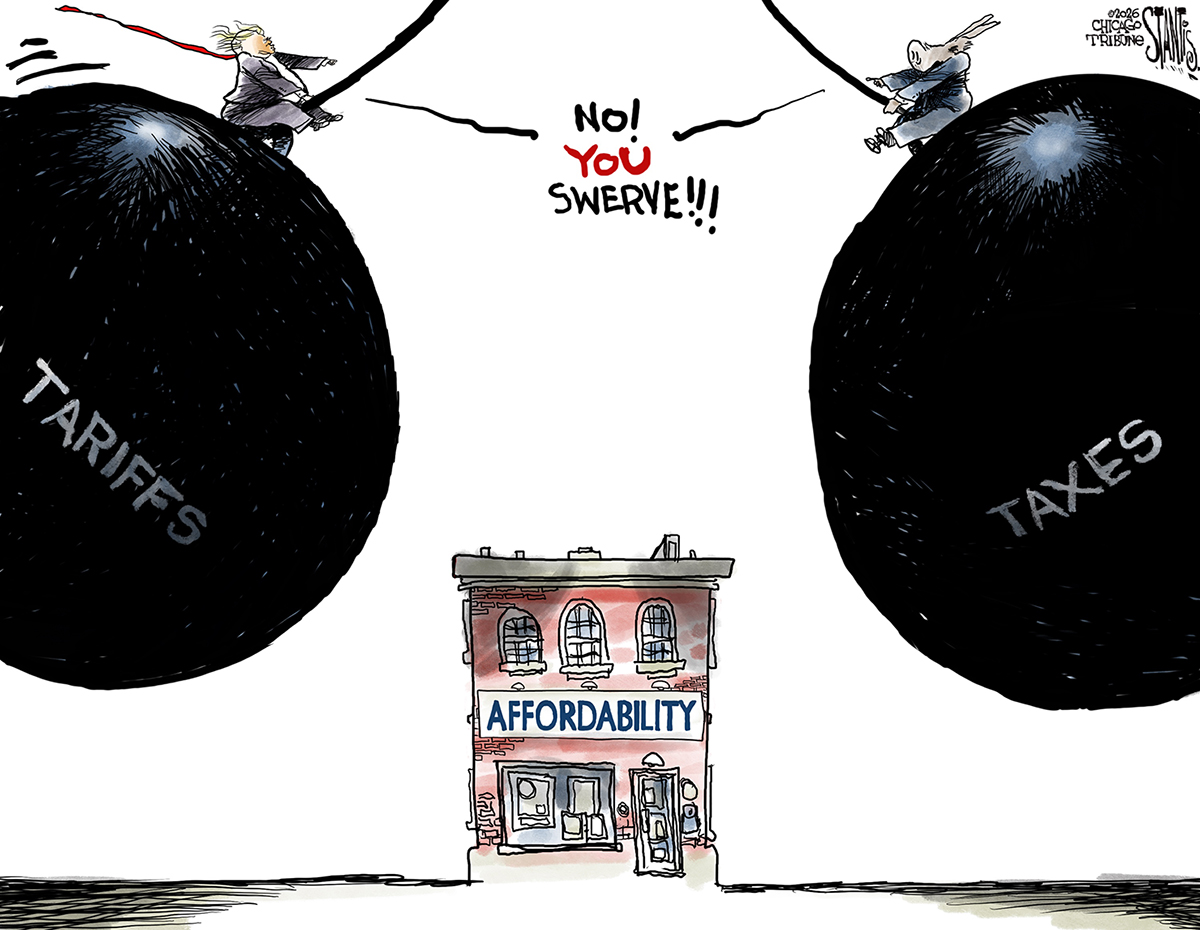There is no real evidence that Trump voters are turning on Trump
Wishing won't make it so!


We are nearly 100 days into Donald Trump's presidency, and the most remarkable aspect of it thus far is that the political environment hasn't changed much at all. The same media that largely ignored the widespread dissatisfaction with the political establishment and wrote off Trump's electoral chances continue looking for evidence that the president has lost traction with the people who elected him. The effort to write the Trump-remorse narrative began in the Republican primaries, when analysts and the media expected GOP voters to eventually rally around a Trump alternative, and continues even now. But still, reality continues to confound those efforts.
So what evidence do observers offer that Trump voters have buyer's remorse?
First, last night's special election in Georgia, where Democrat Jon Ossoff came out of seemingly nowhere in recent weeks, and ended up capturing 48 percent of the vote in a splintered field. But because he failed to eclipse 50 percent, Ossoff now faces Republican Karen Handel in a June run-off. Despite his strong performance Tuesday, Ossoff is now all but assured to lose in a one-on-one race in this deep-red district. No one should read too much into this one idiosyncratic congressional election. It was not a referendum on Trump.
The Week
Escape your echo chamber. Get the facts behind the news, plus analysis from multiple perspectives.

Sign up for The Week's Free Newsletters
From our morning news briefing to a weekly Good News Newsletter, get the best of The Week delivered directly to your inbox.
From our morning news briefing to a weekly Good News Newsletter, get the best of The Week delivered directly to your inbox.
Exhibit B in the buyer's remorse case: A tough special election in Kansas to fill the empty House seat of now-CIA director Mike Pompeo gave media analysts an opening to tie the tight race to Trump. Republican Mike Estes ended up in a virtual tie in late polling against Democrat James Thompson, and the suddenly close contest in a district with a Cook index of Republican +15 forced national Republicans to dump late cash and attention on the race. Estes wound up winning by seven points in the special election, a result which caused some Democrats to declare a moral victory.
"If we can make Republicans go into full-on freakout mode in a ruby red Kansas congressional district now," one progressive activist declared, "we have the power to rip the gavel out of Paul Ryan's hands in November 2018." The Washington Post described the election result as "the best evidence we've got that right now, voters in traditionally Republican districts aren't thrilled with Trump." Even the conservative Washington Examiner called the result "a warning sign for the House Republican majority less than 100 days into the Trump administration."
But was it? Estes ran for the seat while serving as the incumbent state treasurer for Kansas in the administration of Gov. Sam Brownback (R). Brownback's fortunes have declined sharply in his second term, and he is now one of the most unpopular governors in the country, with an approval rating of 27 percent — just getting edged out of last place by Chris Christie's 25 percent in New Jersey. The local reporting on Estes' struggles focused much more on his connections to Brownback than President Trump. In fact, the final push from national Republicans came from Paul Ryan and Trump himself, who recorded a message for voters in Kansas' 4th congressional district assuring voters that Estes had his full endorsement.
Rather than the special election amounting to a referendum on Trump, the sequence of events tends to show that Trump can get voters to the polls even late in the game.
A free daily email with the biggest news stories of the day – and the best features from TheWeek.com
Exhibit C: A New York Times feature of a swing district in Pennsylvania offered up anecdotal evidence of a loss of confidence, but not much data otherwise. The headline of the story framed Trump voters at a loss for "when the 'winning' will start," but only one person in the story seemed to have actually changed her mind about Trump. The 8th congressional district lies mainly within Bucks County, where Hillary Clinton actually edged out Trump in November by 3,000 votes, despite the R+2 advantage, and even though Pat Toomey won his Senate race there by over 18,000 votes. A handful of precincts in PA-08 come from Montgomery County, where Clinton won 59-37, making PA-08 an odd choice for an argument about a post-inaugural letdown.
Next up in the Trump remorse case: A new Gallup survey also posited a retreat by Trump voters that appears illusory. In a follow-up to a February poll taken immediately after Trump's inauguration, Gallup measured voter assessment of six personal qualities of Trump, and found erosion on all six. The most significant erosion was on "image among Americans as someone who keeps his promises," their analysis noted, "falling from 62 percent in February to 45 percent." That indicates, Gallup concluded, that "Trump has lost significant ground with a public that only two months ago credited him with having one of the key characteristics of a successful president."
Perhaps that's a signal for potential problems ahead, but that conclusion misses a rather important point. Trump's overall job approval in the February survey was 46 percent — just a single point about the latest iteration of the same survey, 45 percent, statistically no change over two months. Overall, voters appear to express a consistent view of Trump's performance.
Finally, a new Pew poll taken at roughly the same time shows a similarly consistent — if low — approval rating of 39 percent in both February and April. Pew takes readers through some negative demographic results, including a dismal 33/60 among women. Later, though, the analysis explains why Trump's support remains stable in polling. "Overall, 59 percent say Trump has done about as they expected, while 20 percent say he's done worse than they expected and 19 percent say he's done better," Pew notes. Combined, 78 percent believe Trump has performed at expectations or above them, even with the demographic struggles and low personal-quality polling.
Perhaps there will come a time when Trump voters actually do turn on him and either vote for Democrats or don't turn out at all. So far, though, there is no actual evidence that's happening now. There is enough polling and anecdotal evidence to conclude that Trump voters have enough patience to give their candidate more than 90 days to get his agenda accomplished. They seem to have more patience than the media does in jumping to conclusions, at any rate.
Edward Morrissey has been writing about politics since 2003 in his blog, Captain's Quarters, and now writes for HotAir.com. His columns have appeared in the Washington Post, the New York Post, The New York Sun, the Washington Times, and other newspapers. Morrissey has a daily Internet talk show on politics and culture at Hot Air. Since 2004, Morrissey has had a weekend talk radio show in the Minneapolis/St. Paul area and often fills in as a guest on Salem Radio Network's nationally-syndicated shows. He lives in the Twin Cities area of Minnesota with his wife, son and daughter-in-law, and his two granddaughters. Morrissey's new book, GOING RED, will be published by Crown Forum on April 5, 2016.
-
 Political cartoons for January 18
Political cartoons for January 18Cartoons Sunday’s political cartoons include cost of living, endless supply of greed, and more
-
 Exploring ancient forests on three continents
Exploring ancient forests on three continentsThe Week Recommends Reconnecting with historic nature across the world
-
 How oil tankers have been weaponised
How oil tankers have been weaponisedThe Explainer The seizure of a Russian tanker in the Atlantic last week has drawn attention to the country’s clandestine shipping network
-
 The billionaires’ wealth tax: a catastrophe for California?
The billionaires’ wealth tax: a catastrophe for California?Talking Point Peter Thiel and Larry Page preparing to change state residency
-
 Bari Weiss’ ‘60 Minutes’ scandal is about more than one report
Bari Weiss’ ‘60 Minutes’ scandal is about more than one reportIN THE SPOTLIGHT By blocking an approved segment on a controversial prison holding US deportees in El Salvador, the editor-in-chief of CBS News has become the main story
-
 Has Zohran Mamdani shown the Democrats how to win again?
Has Zohran Mamdani shown the Democrats how to win again?Today’s Big Question New York City mayoral election touted as victory for left-wing populists but moderate centrist wins elsewhere present more complex path for Democratic Party
-
 Millions turn out for anti-Trump ‘No Kings’ rallies
Millions turn out for anti-Trump ‘No Kings’ ralliesSpeed Read An estimated 7 million people participated, 2 million more than at the first ‘No Kings’ protest in June
-
 Ghislaine Maxwell: angling for a Trump pardon
Ghislaine Maxwell: angling for a Trump pardonTalking Point Convicted sex trafficker's testimony could shed new light on president's links to Jeffrey Epstein
-
 The last words and final moments of 40 presidents
The last words and final moments of 40 presidentsThe Explainer Some are eloquent quotes worthy of the holders of the highest office in the nation, and others... aren't
-
 The JFK files: the truth at last?
The JFK files: the truth at last?In The Spotlight More than 64,000 previously classified documents relating the 1963 assassination of John F. Kennedy have been released by the Trump administration
-
 'Seriously, not literally': how should the world take Donald Trump?
'Seriously, not literally': how should the world take Donald Trump?Today's big question White House rhetoric and reality look likely to become increasingly blurred
